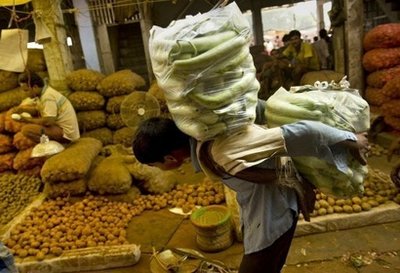SA frets over high food prices
NEW DELHI: Ambika Biswas looks at her grocery bag and winces. She is buying food for her family in one of New Delhi's cheapest markets yet her grocery costs are far higher than last year.
Her maid's income of 5,000 rupees (104 dollars) a month supports her two teenage children and jobless husband.
"These prices go up and up," Biswas, 54, said disbelievingly as she was shopping for India's most important Hindu festival season.
Across South Asia, the refrain is the same.
"We're getting less and paying more," Biswas said.
Biswas, at least, is relatively well-off in Indian terms with a regular job and employers that help her with extra food and clothes.
But hundreds of millions of India's poorer masses are struggling with having to pay more for food.
"They substitute two meals for one or go without," said Devinder Sharma, who chairs the New Delhi-based Forum for Biotechnology and Food Security.
Hit by the lowest monsoon rains since 1972 that have left rice, sugar cane and groundnut crops to shrivel under a hot sun, food prices have soared.
Prices for food basics have shot up as a result of the drought which has reduced farm yields, leading to hoarding and speculation, experts say.
"Only 40 percent of India's farm land is irrigated -- 60 percent of farmers rely on the benevolence of the rain gods," said Deepak Lalwani, India director at stockbrokers Astaire and Partners Ltd. in London.
Last week's inflation numbers underscored the impact of the poor rains.
Raw food items were up by more than 16 percent on an annual basis, driven mainly by a 50-percent rise in vegetable prices.
Prices of potatoes were up by 81 percent, sugar was up by 44 percent, pulses were 20 percent higher and rice had risen by 19 percent.
Food inflation "is messing up family budgets because if you spend so much on food you have to cut back on other things," Indian credit rating agency Crisil economist D.K. Joshi said.
The government in its effort to support India's 235 million farmers has pushed up so-called "minimum support prices" to give them better incomes and this too has pushed prices higher.
The government has food distribution programmes to shelter the very poor from the ravages of inflation but massive corruption means a major portion gets siphoned off before it reaches the intended recipients.
India has also raided food commodities hoarders and the government has appealed to consumers not to panic about shortages.
"We're in a situation we can handle" thanks to successive bumper harvests, said Finance Minister Pranab Mukherjee.
But the Food Security Risk Index, prepared by Maplecroft, a British firm that provides risk intelligence for businesses, puts South Asia's three most populous countries -- India, Bangladesh and Pakistan at high risk of food shortages -- and consequently even higher food prices -- down the road.
"India may be one of the world's key emerging economies, but it is finding itself under increasing pressure from food security issues," a Maplecroft report said, citing a drop in land under cultivation and dwindling water resources.
Prices have rocketed not only in India. As Nepal's Hindu religious festivities get under way, Sarita Khanal, 35, said she was struggling to make ends meet as she shopped for seasonal treats.
"Every time I visit a shop, prices are higher," she told AFP.
Nepalese authorities say food prices have risen by more than 30 percent in the past few months alone following a long winter drought and weak monsoon.
India's ban on exports of rice, wheat and lentils as it seeks to protect domestic supplies has exacerbated problems caused by Nepal's poor harvest.
"Nepalese people spend around 60 percent of their income on food consumption and current trends suggest spending on food is likely to go up," said Bijaya Shrestha, economics professor at Kathmandu's Tribhuvan University.
"These are early warning signs that large numbers of people will go hungry."
The food price shock hit nearby Bangladesh in 2008 when food costs almost doubled after the country's grain output was devastated by major flooding and a catastrophic cyclone the previous year.
"The number of people unable to meet their minimum food needs rose by 7.5 million in 2008, bringing the total number to 65 million people," said World Food Programme country head John Aylieff.
"So 65 million people in this country cannot even make up their minimum food needs," he said.
And it's not going to get any better.
"High food prices are the harsh new reality," said the Food and Agriculture Organisation, which projects the world will need 70 percent more food by 2050 due to higher populations and rising incomes.






